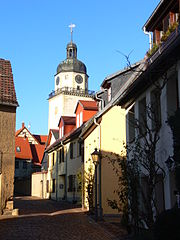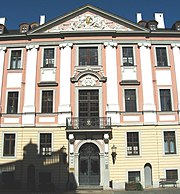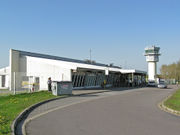| Main | Births etc |
|---|
| Altenburg | |
|---|---|
| Country | Germany |
| State | Thuringia |
| Admin. region | |
| District | Altenburger Land |
| Founded | |
| First mentioned | |
| Subdivisions | 4 |
| Government | |
| • Lord Mayor | Michael Wolf (SPD) |
| Area | |
| • Total | 45.60 km2 (17.61 sq mi) |
| Elevation | 227 m (745 ft) |
| Population (2010-12-31)[1] | |
| • Total | 34,972 |
| • Density | 770/km2 (2,000/sq mi) |
| Time zone | CET/CEST (UTC+1/+2) |
| Postal codes | 04600 |
| Dialling codes | 03447 |
| Vehicle registration | ABG |
| Website | www.altenburg.eu |
Altenburg [listen] (help·info) is a town in the German federal state (Bundesland) of Thuringia, 45 km south of Leipzig. It is the capital of the Altenburger Land district.
Geography[]
Altenburg is bounded by Windischleuba, Nobitz, Saara, Altkirchen, Göhren, Lödla, Rositz, Wintersdorf and Gerstenberg.
History[]

Altenburg about the year 1650

Castle of Altenburg

The Nikolai quarter is one of the oldest parts of Altenburg
The town (civitas Altenburg) was first mentioned in a deed to the Bishop of Zeitz in 976. Remains of a Slavic castle on the Schloßberg ("Castle Hill") demonstrate that the town was probably a Slavic foundation, the capital of the shire of Plisni, taken over during the conquest of Meißen by Henry I. As shown by place names, the surrounding area (Osterland) was mainly settled by Slavs.
The town's location on the imperial road between Halle and Cheb in Bohemia gave Altenburg economic importance in the salt trade.
The first castle, located under the present day church St. Bartholomäi, was destroyed after the Battle of Hohenmölsen between Henry IV and Rudolph of Swabia. It was rebuilt on the Schloßberg outside of the town. The 11th century Mantelturm tower is still preserved. The castle later became an imperial palatinate and played an important part in the German takeover and settlement of the area between the Harz-mountains and the Elbe.
In the middle of the 12th century, the Hohenstaufen emperors patronized Altenburg, allowing the town to become a market and a mint. Together with the Royal forests Leina, Pahna, Kammerforst and Luckauer Forst, lands of the Groitzsch family bought by Frederick Barbarossa, Altenburg, Colditz, Zwickau and Chemnitz were turned into the Terra Plisnensis. Altenburg and Chemnitz as Imperial towns were intended to reduce the importance of Leipzig held by the Margrave of Meißen. Under Frederick Barbarossa much building took place, especially in the market area, and the town grew rapidly. An priory of canons regular was founded and the parish church was finished in 1172. The twin towers (Rote Spitzen) are still preserved. A town wall was constructed at the end of the 12th century.
During the Interregnum, the Terra Plisnensis was impounded, but bought back by Rudolph I of Germany, who desired the crown of Thuringia. Together with Zwickau and Chemnitz, Altenburg was part of the anti-Meißen Pleiße-city Union of 1290. After the Battle of Lucka in 1307 against Frederick the Brave of Meißen and his brother Diezmann, King Albert I lost Altenburg and the Pleiße-lands to the margraves of Meißen.
In 1455, Altenburg saw the division (Altenburger Teilung) of the Meißen lands between Elector Frederick II (the Gentle) and Duke William that led, after a failed attempt at reconciliation (Hallescher Machtspruch) to a war (1446–1451) between the two brothers (Bruderkrieg). In the second division of the Wettin lands between Ernest and Albert at Leipzig in 1485, Altenburg fell to Ernest, together with the Electorate (Kurland), Grimma, the Mutschener Pflege, Leisnig, Thuringia and the Vogtland. From this time on, Altenburg was historically connected with Thuringia. During the German Peasants' War of 1525, the Altenburg Augustinian monastery was attacked. In the summer, four peasant rebels were executed at the marketplace.
From 1603 to 1672, Altenburg was the residence of the Ernestine line, after that, it fell to Saxe-Gotha-Altenburg. During the Napoleonic wars it was a scene of a brief Allied raid by the Saxon General Johann von Thielmann. When the Ernestine lands were re-divided in 1826, Altenburg became the capital of Saxe-Altenburg. The last duke abdicated on 13 November 1918 after being promised 12 million Marks and the ownership of numerous castles. The free-state Saxe-Altenburg was merged with Thuringia in 1920.
During World War II, several subcamps of the Buchenwald concentration camp were located here. They provided forced labour for HASAG, the third largest Germany company to use concentration camp labour.[2]
In 1952, Altenburg fell to the Leipzig District, but became part of Thuringia again in 1990.
Historical population[]
| 1831 - 1939 | 1946 - 1996 | 1997 - 2004 |
|
|
- Source (since 1994): Thüringer Landesamt für Statistik
Main sights[]
Altenburg's town hall is one of the most important Renaissance buildings in Germany. It was built between 1562 and 1564 by the architect Nikolaus Grohmann. The Schenkendorffsches Palais (1724) and the Alte Amtshaus (1725) are remarkable Baroque structures. There is also a castle, which is the scene of the famous Prinzenraub, related by Carlyle in his "Miscellanies". The Western main wing (1706–1732) contains an exhibition on the history of playing cards and card games and an historical museum.

Town Hall.
The Lindenau-Museum in the palace of Bernhard August von Lindenau, was built in 1875 and houses Italian paintings of the 13th-15th centuries, a collection of classical antiquities and cast and modern art. The scientific museum Mauritianum shows the largest well-known mummified rat king, which was found in 1828 in a miller's fireplace at Buchheim.

Castle - Corps de Logis.

Altenburg Theatre,
Other points of interest include the Botanischer Erlebnisgarten Altenburg, a small botanical garden.
Culture[]
Altenburg is called the playing cards town. The game of skat is said to have originated here, based on the Bavarian tarock. Because of the influence Emperor Frederick Barbarossa had on the town, it is nicknamed a "Barbarossa town".
Economy[]

Gumpert Apollo
Altenburg is noted for produced playing cards. The Altenburger Spielkartenfabrik was founded in 1831. Today it is a subsidiary company of Cartamundi and market leader in Germany.
In Altenburg is the headquarters of the Gumpert Sportwagenmanufaktur. The Gumpert Apollo supercar has been produced by Gumpert Sportwagenmanufaktur since 2005.
Altenburg is also known for its mustard, which is produced by Altenburger Senf und Feinkost.
Transport[]
Local transport[]
Local transport within Altenburg relies exclusively on buses. 6 lines connect the outlying quarters to the downtown.
Rail[]
Altenburg station is on the Leipzig–Hof line
Airport[]

Leipzig-Altenburg Airport
In the vicinity of the town are two airports.
The Leipzig-Altenburg Airport, a former Russian military airport, is used for cheap commercial flights to London Stansted, Barcelona-Girona and Edinburgh.
Leipzig/Halle is an international airport 50 km northwest of Altenburg.
International relations[]
Altenburg is twinned with:
 Offenburg, Germany
Offenburg, GermanyOlten, Switzerland
Zlín, Czech Republic
Hickory, United States
Notable natives[]
- Friedrich Arnold Brockhaus
- Joachim Büchner
- Carl Adolph Douai
- Frederick I
- Hans Conon von der Gabelentz
- Georg von der Gabelentz
- Johann Georg August Galletti
- Ralf Haber
- Johann Ludwig Krebs
- Bernhard von Lindenau
- Uwe Rösler
- Hermann Schlegel
- Ingo Schulze
- George Spalatin
See also[]
- Petrosomatoglyph. Christs's Fingerprint and the imprint of the Devil's head.
References[]
- ^ "Bevölkerung nach Gemeinden, erfüllenden Gemeinden und Verwaltungsgemeinschaften" (in German). Thüringer Landesamt für Statistik. 31 December 2010. http://www.statistik.thueringen.de/datenbank/TabAnzeige.asp?tabelle=gg000102%7C%7C.
- ^ Edward Victor, Alphabetical List of Camps, Subcamps and Other Camps.
External links[]
Template:Cities and towns in Altenburger Land (district)
| This page uses content from the English language Wikipedia. The original content was at Altenburg. The list of authors can be seen in the page history. As with this Familypedia wiki, the content of Wikipedia is available under the Creative Commons License. |

